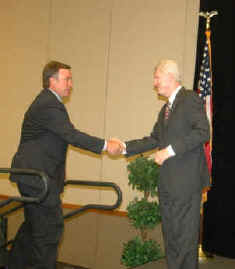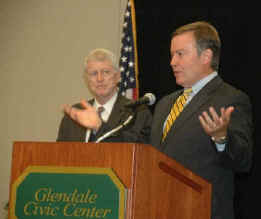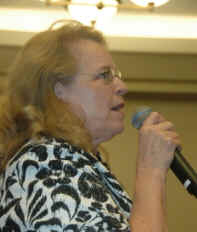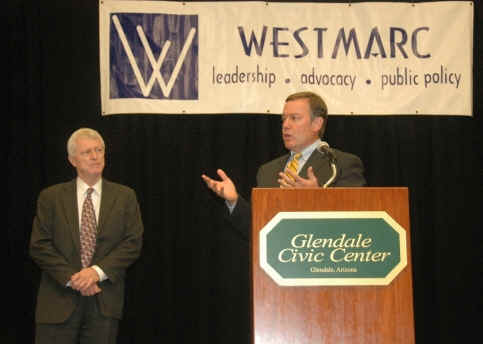|
Promising
an “academic village” at ASU’s West
campus, President Michael
Crow laid out his vision
for the future of the westside institution.
Story
By Markus Risinger - @west
Copy Editor - Special to the Glendale Daily
Planet
Photos by Ed Sharpe Glendale Daily Planet
Below:
(L) Dr Michael Crow ASU Prisident is greeterd
by (R) Jack Lundsford CEO of WESTMARC,
who was the host for this forum.
 Speaking
in front of more than 100 people at the Glendale Civic Center this week,
ASU President Michael Crow
described the current state
of affairs in Arizona,
as well as his plans for ASU to help the state get back on track. Speaking
in front of more than 100 people at the Glendale Civic Center this week,
ASU President Michael Crow
described the current state
of affairs in Arizona,
as well as his plans for ASU to help the state get back on track.
At
a luncheon organized by WESTMARC, a leadership coalition of 15 communities
in Western Maricopa County,
Crow explained how the U.S. is defeating itself “by [its] own
success,” as production has grown so efficient that fewer workers can
produce more than in years past. In high-growth states like Arizona, Crow
said that the absence of economic diversity is the greatest contributor to
what he described as “the worst economic shock in Arizona’s history”
in 2009. According to Crow, 12 percent of Arizonans who held jobs at the
end of 2008 no longer held them at the end of 2009.
Crow
told West Valley leaders that he believes ASU’s West campus will play an
integral role if Arizona is to compete with the rest of the country. He
explained that, in order to secure Arizona’s future, “We have to win
in the knowledge game. We have to win in the knowledge production game. We
have to win in the idea game.” This would mean graduating 30,000
additional students in the state each year if Arizona is to reach the
national average, Crow said. Further development of ASU’s “One
University, Many Places” policy will aid in this venture, according to
Crow, who urged those in attendance to think of the university as
geographically unbound.
 President
Crow elaborated on his plan to acquire private funding to build an
“academic village” at the West campus, where students would live in
dormitories sorted by colleges, as well as having greater access to
academic facilities, dining and other resources. President
Crow elaborated on his plan to acquire private funding to build an
“academic village” at the West campus, where students would live in
dormitories sorted by colleges, as well as having greater access to
academic facilities, dining and other resources.
West
campus’ New
College of Interdisciplinary Arts and Sciences will experience
tremendous growth in the years to come, Crow said, mostly due to the fact
that Tempe’s College of Liberal Arts and Sciences has grown larger than
the entire University of Oregon. Programs will eventually be routed to
West in order to accommodate more students. Crow cited this plan as the
reason ASU moved the rest of the West campus’s programs elsewhere in
2009, while making no mention of the budget crisis that the university
faced at the time. The New College should also expect to receive a new
name in the near future, similar to the restructuring and rebranding of
the former College of Teacher
Education and Leadership, now the Mary
Lou Fulton Teachers College.
 When
asked by Arizona District 10 Senator
Linda Gray (Shown at left) when the West campus and its
surrounding communities should expect growth to return after thousands of
students were forced to move closer to downtown Phoenix and Tempe last
year, Crow assured that he is “100% confident that the West campus is on
track.” He gave no timetable, however, for when he expects the
population to reach the 15,000-20,000 students he projects will attend the
West campus in the future. Crow insisted that West has a “very, very
important assignment” to provide a platform from which West Valley
students can launch their careers, but there was little in his speech to
suggest when - or if - that assignment will ever become one of ASU’s top
priorities. When
asked by Arizona District 10 Senator
Linda Gray (Shown at left) when the West campus and its
surrounding communities should expect growth to return after thousands of
students were forced to move closer to downtown Phoenix and Tempe last
year, Crow assured that he is “100% confident that the West campus is on
track.” He gave no timetable, however, for when he expects the
population to reach the 15,000-20,000 students he projects will attend the
West campus in the future. Crow insisted that West has a “very, very
important assignment” to provide a platform from which West Valley
students can launch their careers, but there was little in his speech to
suggest when - or if - that assignment will ever become one of ASU’s top
priorities.

L- Jack Lundsford CEO WESTMARC
- R- Dr. Michael Crowe President of ASU |

